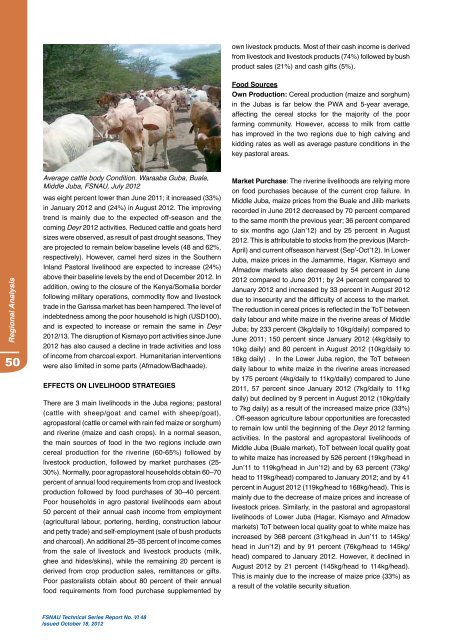Fsnau-Post-Gu-2012-Technical-Report
Fsnau-Post-Gu-2012-Technical-Report
Fsnau-Post-Gu-2012-Technical-Report
Create successful ePaper yourself
Turn your PDF publications into a flip-book with our unique Google optimized e-Paper software.
Regional Analysis<br />
50<br />
Average cattle body Condition. Waraaba <strong>Gu</strong>ba, Buale,<br />
Middle Juba, FSNAU, July <strong>2012</strong><br />
was eight percent lower than June 2011; it increased (33%)<br />
in January <strong>2012</strong> and (24%) in August <strong>2012</strong>. The improving<br />
trend is mainly due to the expected off-season and the<br />
coming Deyr <strong>2012</strong> activities. Reduced cattle and goats herd<br />
sizes were observed, as result of past drought seasons, They<br />
are projected to remain below baseline levels (48 and 62%,<br />
respectively). However, camel herd sizes in the Southern<br />
Inland Pastoral livelihood are expected to increase (24%)<br />
above their baseline levels by the end of December <strong>2012</strong>. In<br />
addition, owing to the closure of the Kenya/Somalia border<br />
following military operations, commodity flow and livestock<br />
trade in the Garissa market has been hampered. The level of<br />
indebtedness among the poor household is high (USD100),<br />
and is expected to increase or remain the same in Deyr<br />
<strong>2012</strong>/13. The disruption of Kismayo port activities since June<br />
<strong>2012</strong> has also caused a decline in trade activities and loss<br />
of income from charcoal export. Humanitarian interventions<br />
were also limited in some parts (Afmadow/Badhaade).<br />
EFFECTS ON LIVELIHOOD STRATEGIES<br />
There are 3 main livelihoods in the Juba regions; pastoral<br />
(cattle with sheep/goat and camel with sheep/goat),<br />
agropastoral (cattle or camel with rain fed maize or sorghum)<br />
and riverine (maize and cash crops). In a normal season,<br />
the main sources of food in the two regions include own<br />
cereal production for the riverine (60-65%) followed by<br />
livestock production, followed by market purchases (25-<br />
30%). Normally, poor agropastoral households obtain 60–70<br />
percent of annual food requirements from crop and livestock<br />
production followed by food purchases of 30–40 percent.<br />
Poor households in agro pastoral livelihoods earn about<br />
50 percent of their annual cash income from employment<br />
(agricultural labour, portering, herding, construction labour<br />
and petty trade) and self-employment (sale of bush products<br />
and charcoal). An additional 25–35 percent of income comes<br />
from the sale of livestock and livestock products (milk,<br />
ghee and hides/skins), while the remaining 20 percent is<br />
derived from crop production sales, remittances or gifts.<br />
Poor pastoralists obtain about 80 percent of their annual<br />
food requirements from food pur chase supplemented by<br />
FSNAU <strong>Technical</strong> Series <strong>Report</strong> No. VI 48<br />
Issued October 18, <strong>2012</strong><br />
own livestock products. Most of their cash income is derived<br />
from livestock and livestock products (74%) followed by bush<br />
product sales (21%) and cash gifts (5%).<br />
Food Sources<br />
Own Production: Cereal production (maize and sorghum)<br />
in the Jubas is far below the PWA and 5-year average,<br />
affecting the cereal stocks for the majority of the poor<br />
farming community. However, access to milk from cattle<br />
has improved in the two regions due to high calving and<br />
kidding rates as well as average pasture conditions in the<br />
key pastoral areas.<br />
Market Purchase: The riverine livelihoods are relying more<br />
on food purchases because of the current crop failure. In<br />
Middle Juba, maize prices from the Buale and Jilib markets<br />
recorded in June <strong>2012</strong> decreased by 70 percent compared<br />
to the same month the previous year; 36 percent compared<br />
to six months ago (Jan’12) and by 25 percent in August<br />
<strong>2012</strong>. This is attributable to stocks from the previous (March-<br />
April) and current offseason harvest (Sep’-Oct’12). In Lower<br />
Juba, maize prices in the Jamamme, Hagar, Kismayo and<br />
Afmadow markets also decreased by 54 percent in June<br />
<strong>2012</strong> compared to June 2011; by 24 percent compared to<br />
January <strong>2012</strong> and increased by 33 percent in August <strong>2012</strong><br />
due to insecurity and the difficulty of access to the market.<br />
The reduction in cereal prices is reflected in the ToT between<br />
daily labour and white maize in the riverine areas of Middle<br />
Juba; by 233 percent (3kg/daily to 10kg/daily) compared to<br />
June 2011; 150 percent since January <strong>2012</strong> (4kg/daily to<br />
10kg daily) and 80 percent in August <strong>2012</strong> (10kg/daily to<br />
18kg daily) . In the Lower Juba region, the ToT between<br />
daily labour to white maize in the riverine areas increased<br />
by 175 percent (4kg/daily to 11kg/daily) compared to June<br />
2011, 57 percent since January <strong>2012</strong> (7kg/daily to 11kg<br />
daily) but declined by 9 percent in August <strong>2012</strong> (10kg/daily<br />
to 7kg daily) as a result of the increased maize price (33%)<br />
. Off-season agriculture labour opportunities are forecasted<br />
to remain low until the beginning of the Deyr <strong>2012</strong> farming<br />
activities. In the pastoral and agropastoral livelihoods of<br />
Middle Juba (Buale market), ToT between local quality goat<br />
to white maize has increased by 526 percent (19kg/head in<br />
Jun’11 to 119kg/head in Jun’12) and by 63 percent (73kg/<br />
head to 119kg/head) compared to January <strong>2012</strong>; and by 41<br />
percent in August <strong>2012</strong> (119kg/head to 168kg/head). This is<br />
mainly due to the decrease of maize prices and increase of<br />
livestock prices. Similarly, in the pastoral and agropastoral<br />
livelihoods of Lower Juba (Hagar, Kismayo and Afmadow<br />
markets) ToT between local quality goat to white maize has<br />
increased by 368 percent (31kg/head in Jun’11 to 145kg/<br />
head in Jun’12) and by 91 percent (76kg/head to 145kg/<br />
head) compared to January <strong>2012</strong>. However, it declined in<br />
August <strong>2012</strong> by 21 percent (145kg/head to 114kg/head).<br />
This is mainly due to the increase of maize price (33%) as<br />
a result of the volatile security situation.


